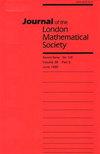Enriques曲面一点爆破的Kähler锥与辛锥的比较
IF 1
2区 数学
Q1 MATHEMATICS
Journal of the London Mathematical Society-Second Series
Pub Date : 2025-03-05
DOI:10.1112/jlms.70117
引用次数: 0
摘要
我们继Cascini-Panov对p g=0$ p_g=0$ Kähler曲面上的辛一般复结构的研究(Li提出的问题)之后,证明了Enriques曲面的一点膨胀允许non-Kähler辛形式。这种现象依赖于恩里克曲面上大量的椭圆纤摇,其特征是代数几何中的各种不变量。我们还提供了这些不变量的定量比较,以进一步详细检查Kähler锥和辛锥之间的区别。本文章由计算机程序翻译,如有差异,请以英文原文为准。
Comparing Kähler cone and symplectic cone of one-point blowup of Enriques surface
We follow the study by Cascini–Panov on symplectic generic complex structures on Kähler surfaces with , a question proposed by Li, by demonstrating that the one-point blowup of an Enriques surface admits non-Kähler symplectic forms. This phenomenon relies on the abundance of elliptic fibrations on Enriques surfaces, characterized by various invariants from the algebraic geometry. We also provide a quantitative comparison of these invariants to further give a detailed examination of the distinction between Kähler cone and symplectic cone.
求助全文
通过发布文献求助,成功后即可免费获取论文全文。
去求助
来源期刊
CiteScore
1.90
自引率
0.00%
发文量
186
审稿时长
6-12 weeks
期刊介绍:
The Journal of the London Mathematical Society has been publishing leading research in a broad range of mathematical subject areas since 1926. The Journal welcomes papers on subjects of general interest that represent a significant advance in mathematical knowledge, as well as submissions that are deemed to stimulate new interest and research activity.

 求助内容:
求助内容: 应助结果提醒方式:
应助结果提醒方式:


